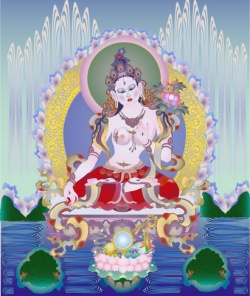Difference between revisions of "White Tara"
| Line 50: | Line 50: | ||
{{R}} | {{R}} | ||
[[Category:Buddhist Terms]] | [[Category:Buddhist Terms]] | ||
| + | [[Category:Deities]] | ||
[[Category:Tara]] | [[Category:Tara]] | ||
[[Category:WhiteTara]] | [[Category:WhiteTara]] | ||
| + | [[Category:Tibetan Buddhism]] | ||
Latest revision as of 13:55, 30 October 2023
White Tara (Skt. Sitatārā; Tib. སྒྲོལ་དཀར་, Drolkar; Wyl. sgrol dkar) — manifestations of Tara, white in colour.
The most well known is White Tara Wishfulfilling Wheel which is the main deity of the Chimé Pakmé Nyingtik sadhana for example. White Tara is called "the Goddess of Seven Eyes" because in addition to the third eye, she is also depicted with eyes in her hands and feet.
This represents White Tara seeing all human suffering, as well as encourages the devotee to develop vigilance and sensitivity to the energy in and around them. White Arya Tara, Jetsün Drolma in Tibetan and she is the embodiment of all Tsagyüd Lamas, “Root Lamas and Lineage Lamas”
In many ways, the energy of White Tara is similar to the energy of Kwan Yin; both goddesses are referred to as mothers and represent a strong and protective flow of compassion.
The way White Tara is definitely different from Kwan Yin is in her feminist associations. White Tara is aways depicted seating in the lotus position with the soles of her feet pointing upward (diamond lotus).
Her left hand is in the protective, no fear mudra, and her right hand makes the compassion and wish granting mudra.
A blue lotus flower is often depicted emerging from White Tara's left hand - an energy expression of a state of fearlessness leading to Buddhahood.
Another association with the powers of White Tara is the energy of health and longevity. She can grant a long life, if one is devoted to the pursuit of truth and universal compassion.
To connect to the powerful energy of White Tara, you can listen to (or chant) the White Tara mantra. White Tara is a female enlightened being whose function is to bestow long life, wisdom, and good fortune.
If we rely upon her with faith, she will protect us from contagious diseases, the dangers of fire, and other disasters.
It is said that living beings receive Tara’s blessings as swiftly as the wind moves because she is the manifestation of the wind element of all Buddhas.
The main characteristic of Arya Tara - Noble Tara - is that she is a Buddha who in earlier times promised to always be born in the pure form of a female body in order to help living beings reach enlightenment.
There are many outer and inner impediments that practitioners encounter, so Arya Tara manifests in order to eliminate hindrances and obstacles one runs in to while on the path to liberation from suffering.
Meditating White Tara is to purify one’s mind of the conceptual and emotional veils that conceal its true nature. Arya Tara also frees from outer hindrances and impediments.
Noble White Tara can extend the time one has in this life so that one can practice the precious Dharma.
The scripture, Yogini-Tantra – The Source of Tara describes how this is possible.
The Yogini-Tantra elucidates how White Arya Tara, from among the 21 Taras, frees practitioners from untimely death.
It is truly possible to extend the span of one’s life by practicing White Tara and this will be very beneficial for one’s Dharma practice.
When beginning a meditation session on White Tara, a disciple pays homage by repeating the Sanskrit words of the first line in the Sadhana, which reads:
Namo Guru Arya Tara Ye.
This is the short phrase one recites at the beginning. By reciting this praise, one pays respect and honours one’s teacher, who is the embodiment of Noble White Tara.
